Public Perception of Innovative Technical Solutions for the Development of the ‘Sponge City’ Concept in Poland: A Case Study of the Tri-City Area
Abstract
1. Introduction
2. Materials and Methods
2.1. Study Aim and the Adopted Research Hypotheses
- (1)
- the extent of diffusion of expert opinions on the role of implementing innovative technical solutions for the development of the “sponge city” concept among respondents is small,
- (2)
- more women than men identify themselves with opinions about the importance of implementing innovative technical solutions for the development of the “sponge city” concept,
- (3)
- the youngest respondents identify themselves with opinions about the importance of implementing innovative technical solutions for the development of the “sponge city” concept significantly more often than those from the other age groups studied.
2.2. Area of Study
2.3. Research Object
2.4. Research Tool
- improving the efficiency of water retention in the ground [19],
- sustainable functioning of cities in terms of the natural water cycle [19],
- improving the sustainability of freshwater abstraction [20],
- reducing the amount of sewage and relieving the burden on the sewage treatment system [19],
- reducing the adverse effects of heavy rainfall [21],
- improving conditions for the functioning of urban ecosystems and green areas [22],
- increasing the awareness of city residents about the importance of small water retention [23],
- increasing investment in research on innovative technical solutions [24],
- increasing competition among companies dealing with innovative technical solutions [25], and
- reducing the price of these solutions [20].
2.5. Statistical Methods for Data Analysis
3. Results and Discussion
3.1. Differences in Distribution of Opinions Due to Differences in Respondents’ Sociodemographic Characteristics
3.2. Differences in the Values of the Feature-Opinion Significance Index (FSI) Determined by Differences in the Respondents’ Sociodemographic Characteristics
4. Conclusions
Author Contributions
Funding
Institutional Review Board Statement
Informed Consent Statement
Data Availability Statement
Acknowledgments
Conflicts of Interest
References
- Stec, A.; Dziopak, J. Rainwater in the landscape architecture of modern cities. Czas. Inżynierii Lądowej Sr. I Archit. 2017, 64, 315–333. [Google Scholar] [CrossRef]
- Hakuć-Błażowska, A.; Napiórkowska-Była, A.; Tyrkowski, K. Selected Aspects of Water and Land Management with Particular Emphasis on Spatial Planning; Instytut Badań Gospodarczych: Olsztyn, Poland, 2020. [Google Scholar] [CrossRef]
- Yang, M.; Chen, D.; Shi, L.; He, J.; Liu, L.; Shang, X. How do construct a sponge city that can improve residents’ satisfaction? Evidence from a suburb of Huizhou City, China. Ecol. Indic. 2022, 142, 109238. [Google Scholar] [CrossRef]
- Zaręba, A.; Krzemińska, A.; Adynkiewicz-Piragas, M.; Widawski, K.; van der Horst, D.; Grijalva, F.; Monreal, R. Water Oriented City—A ‘5 Scales’ System of Blue and Green Infrastructure in Sponge Cities Supporting the Retention of the Urban Fabric. Water 2022, 14, 4070. [Google Scholar] [CrossRef]
- Deng, Y.; Deng, J.; Zhang, C. Sponge City and Water Environment Planning and Construction in Jibu District in Changde City. Sustainability 2023, 15, 444. [Google Scholar] [CrossRef]
- Popkiewicz, M. Understanding the Energy Transformation: From Depression to Vision or How to Dig Yourself out of the Hole We’re in; Sonia Draga Sp. z o. o.: Katowice, Poland, 2022. [Google Scholar]
- Available online: https://www.architekturaibiznes.pl/nawierzchnia-przepuszczalna-pervia-cemex,8483.html (accessed on 5 November 2024).
- Han, H.; Wang, Z.; Li, H. Incentive Mechanism for Inhibiting Developer’s Moral Hazard Behavior in China’s Sponge City Projects. Adv. Civ. Eng. 2019, 2019, 6090683. [Google Scholar] [CrossRef]
- Liu, H.; Jia, Y.; Niu, C. “Sponge city” concept helps solve China’s urban water problems. Environ. Earth Sci. 2017, 76, 473. [Google Scholar] [CrossRef]
- Frankowski, P.; Zbierska, J.; Staniszewski, R.; Kayzer, D. The influence of water reservoirs in Nienawiszcze on the improvement of visual values of the landscape. Nauka Przyr. Technol. 2018, 12, 18. [Google Scholar] [CrossRef]
- He, B.J.; Zhu, J.; Zhao, D.X.; Gou, Z.H.; Qi, J.D.; Wang, J. Co-benefits approach: Opportunities for implementing sponge city and urban heat island mitigation. Land Use Policy 2019, 86, 147–157. [Google Scholar] [CrossRef]
- McGrane, S.J. Impacts of urbanisation on hydrological and water quality dynamics, and urban water management: A review. Hydrol. Sci. J. 2016, 61, 2295–2311. [Google Scholar] [CrossRef]
- Ignatieva, M.; Mofrad, F. Understanding Urban Green Spaces Typology’s Contribution to Comprehensive Green Infrastructure Planning: A Study of Canberra, the National Capital of Australia. Land 2023, 12, 950. [Google Scholar] [CrossRef]
- Piazza, S.; Sambito, M.; Maglia, N.; Puoti, F.; Raimondi, A. Enhancing urban water resilience through stormwater reuse for toilet flushing. Sustain. Cities Soc. 2025, 119, 106074. [Google Scholar] [CrossRef]
- Available online: https://pl.m.wikipedia.org/wiki/Podzia%C5%82_administracyjny_Polski (accessed on 24 February 2025).
- Barends, E.; Rousseau, D.M. Evidence-Based Management: How to Use Evidence to Make Better Organizational Decisions; Kogan Page Publishers: London, UK, 2018. [Google Scholar]
- Boguszewski, R.; Makowska, M.; Podkowińska, M. A Typology of Poles’ Attitudes toward COVID-19 during the First Wave of the Pandemic. Int. J. Environ. Res. Public Health 2021, 18, 2002. [Google Scholar] [CrossRef] [PubMed]
- Murdoch, M.; Simon, A.B.; Polusny, M.A.; Bangerter, A.; Grill, J.P.; Noorbaloochi, S.; Partin, M.R. Impact of different privacy conditions and incentives on survey response rate, participant representativeness, and disclosure of sensitive information: A randomized controlled trial. BMC Med. Res. Methodol. 2014, 14, 90. [Google Scholar] [CrossRef] [PubMed]
- Gryszpanowicz, P.; Prałat, K.; Lisicka, A. Analysis of the potential for increasing water retention in road pavements on public roads in cities: A case study based on the Old Town of Płock. Bud. I Archit. 2024, 23, 073–085. [Google Scholar] [CrossRef]
- Wang, J.; Zhou, X.; Wang, S.; Chen, L.; Shen, Z. Simulation and Comprehensive Evaluation of the Multidimensional Environmental Benefits of Sponge Cities. Water 2023, 15, 2590. [Google Scholar] [CrossRef]
- Sikora, M.; Cieśliński, R. The formation of the outflow in the urbanised catchment area on the example of the catchment of strzyża. Inżynieria Ekol. 2015, 41, 69–78. [Google Scholar] [CrossRef][Green Version]
- Szydłowski, M.; Gulshad, K.; Mustafa, A.; Szpakowski, W. The impact of hydrological research, municipal authorities, and residents on rainwater management in Gdańsk (Poland) in the process of adapting the city to climate change. Acta Sci. Pol. Form. Circumiectus 2023, 22, 59–71. [Google Scholar] [CrossRef]
- Bernaciak, A.; Spychała, M.; Korytowski, M.; Powolna, P. Small water retention in local environmental protection programs of warta river municipalities. Ecol. Eng. Environ. 2015, 44, 121–130. [Google Scholar] [CrossRef]
- Krusinskas, R.; Norvaisiene, R.; Lakstutiene, A.; Vaitkevicius, S. Investment, innovation and firm performance: Empirical evidence from small manufacturing industries. J. Financ. Econ. 2015, 3, 122–131. [Google Scholar] [CrossRef]
- Pichlak, M. Environmental innovations as a source of company’s competitive advantage. Sci. Pap. Silesian Univ. Technol. Organ. Manag. Ser. 2017, 102, 303–318. [Google Scholar] [CrossRef]
- Łomnicki, A. Introduction to Statistics for Naturalists; PWN: Warszawa, Poland, 2014. [Google Scholar]
- Gaworski, M.; Borowski, P.F.; Zajkowska, M. Attitudes of a group of young Polish consumers towards selected features of dairy products. Agron. Res. 2021, 19, 1023–1038. [Google Scholar] [CrossRef]
- Lamm, A.J.; Lamm, K.W.; Trojan, S.; Sanders, C.E.; Byrd, A.R. A Needs Assessment to Inform Research and Outreach Efforts for Sustainable Agricultural Practices and Food Production in the Western United States. Foods 2023, 12, 1630. [Google Scholar] [CrossRef] [PubMed]
- Korneć, J. Changes climatic as global challenge of the 21st century. Nauka I Szt. Młodych 2024, 51–54. [Google Scholar]
- Skrzyńska, M. Sixth The IPCC report as the newest source information about changes climate. Energetyka 2023, 9, 527–534. [Google Scholar]
- Available online: https://archiwum.mwik.bydgoszcz.pl/index.php/component/attachments/download/445 (accessed on 3 December 2024).
- Błasiak-Nowak, B.; Rajczewska, M. Agenda 2030 in Poland—Preparation for implementation goals Sustainable development. Kontrola Państwowa 2018, 63, 70–83. [Google Scholar]
- Balcer, A.; Buras, P.; Gromadzki, G.; Smolar, E. Polish Views of the EU: The Illusion of Consensus. Stefan Batory Foundation 2017. Available online: https://www.batory.org.pl/upload/files/pdf/rap_otw_eu/Polish%20views%20of%20the%20EU.pdf (accessed on 18 December 2024).
- Jaskulowski, K. The Everyday Politics of Migration Crisis in Poland: Between Nationalism, Fear and Empathy; Springer: Cham, Swotzerland, 2019. [Google Scholar] [CrossRef]
- Davidson, M.J.; Burke, R.J. Women in management worldwide: Progress and prospects—An overview. In Women in Management Worldwide; Gower: Aldershot, UK, 2016; pp. 19–36. [Google Scholar]
- Akinwale, A.A. Gender equity and social progress: Empowering women and girls to drive sustainable development in SUB–SAHARAN AFRICA. Int. J. Innov. Res. Adv. Stud. 2023, 2, 131–153. [Google Scholar]
- Available online: https://www.kpo.gov.pl/strony/o-kpo/o-kpo/informacje/ (accessed on 31 December 2024).
- Prokop, V.; Hojnik, J.; Zapletal, D.; Žižmond, E. On the path to sustainable development: The nexus among owner gender diversity, energy management, and firms’ innovation radicalness. Bus. Strategy Environ. 2023, 32, 1799–1815. [Google Scholar] [CrossRef]
- Maciejewski, G. Young consumers’ attitudes towards product innovation. Konsumpcja I Rozw. 2016, 14, 19. [Google Scholar]
- Ilbeykina, M.I.; Kolesnik, M.A.; Libakova, N.M.; Sertakova, E.A.; Sitnikova, A.A. Innovation and personality: A study of attitude to innovation among Krasnoyarsk students and business experts using the Basadur-Hausdorff method. Mediterr. J. Soc. Sci. 2015, 6, 282. [Google Scholar] [CrossRef]

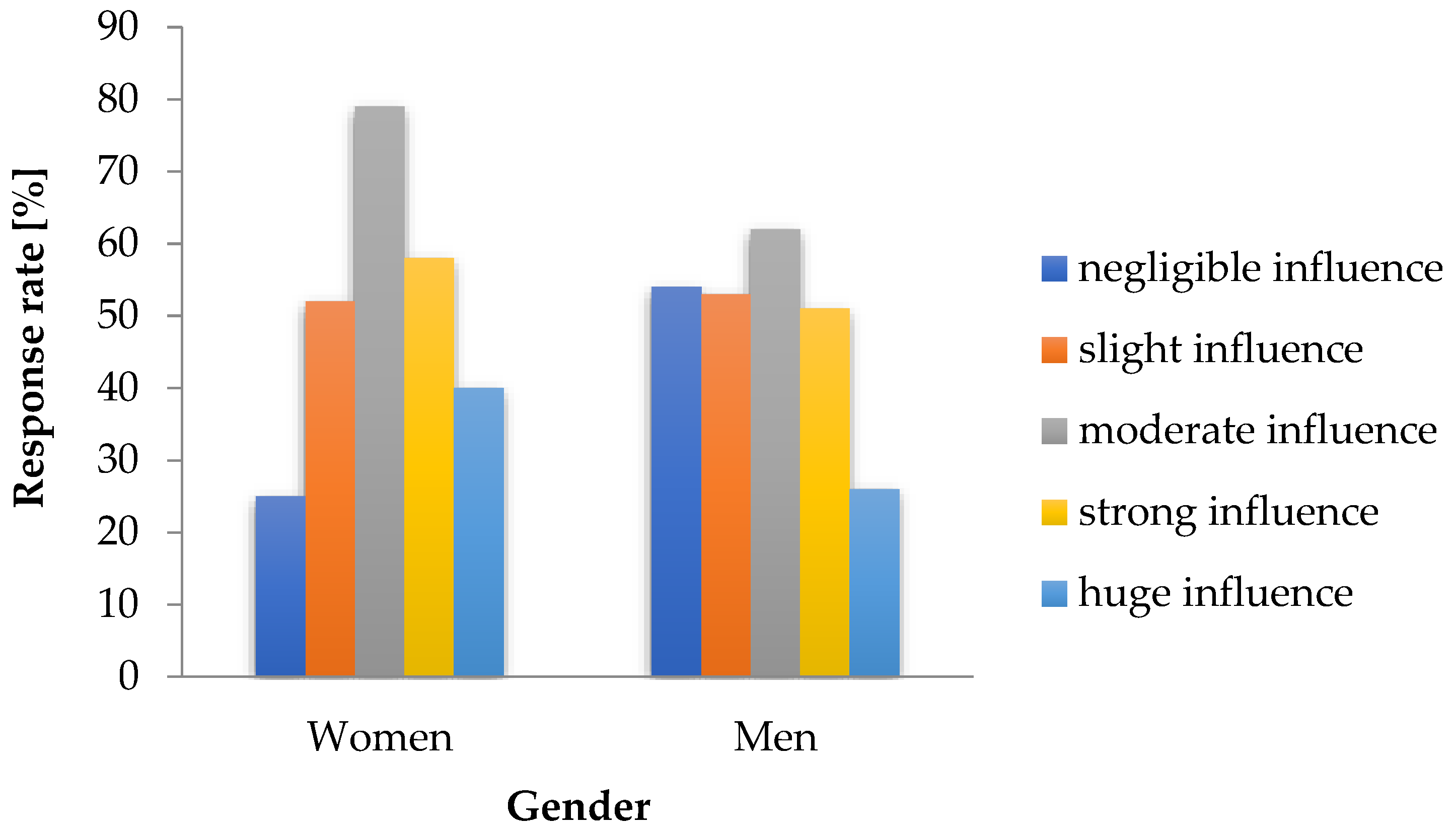
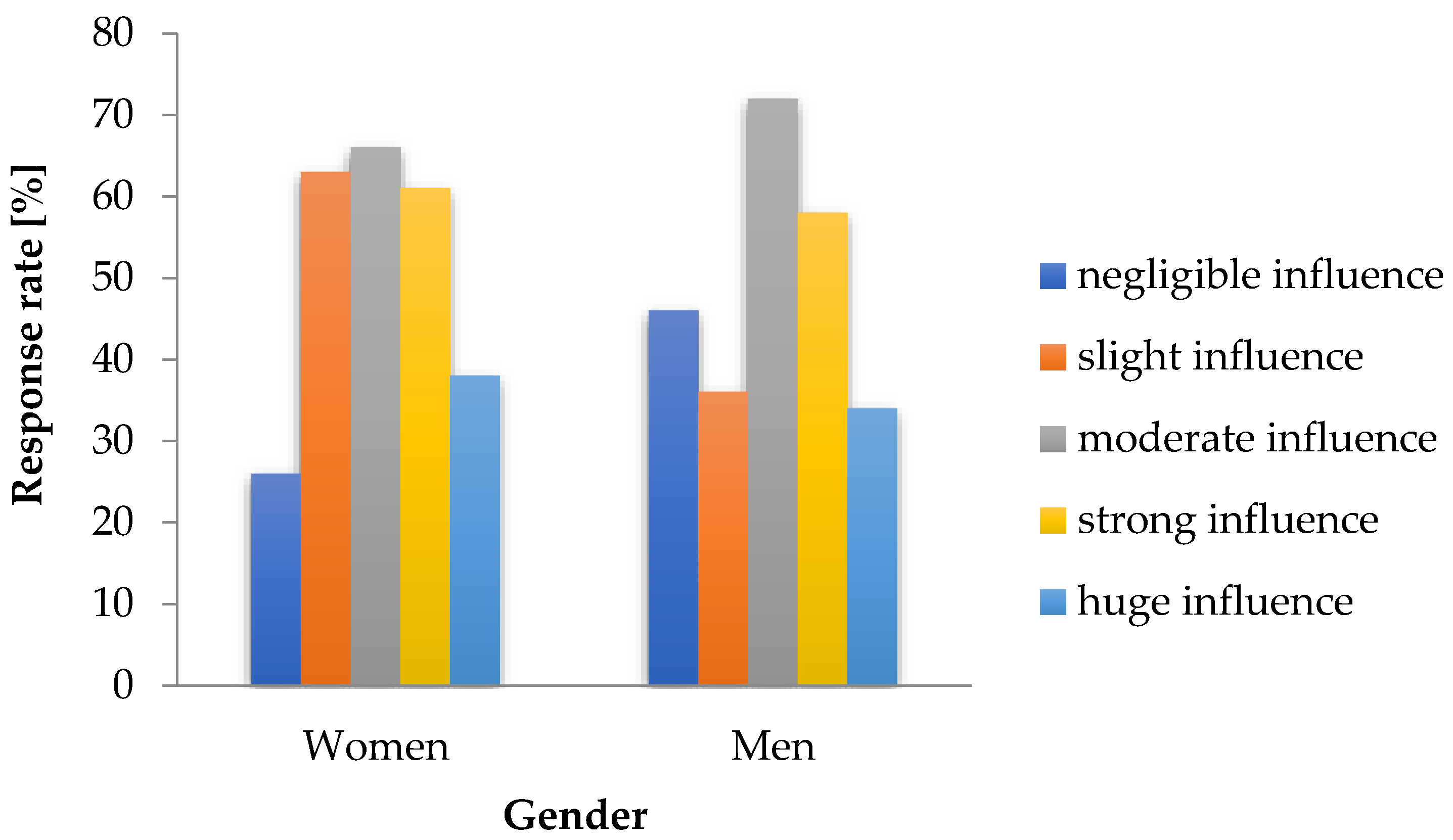
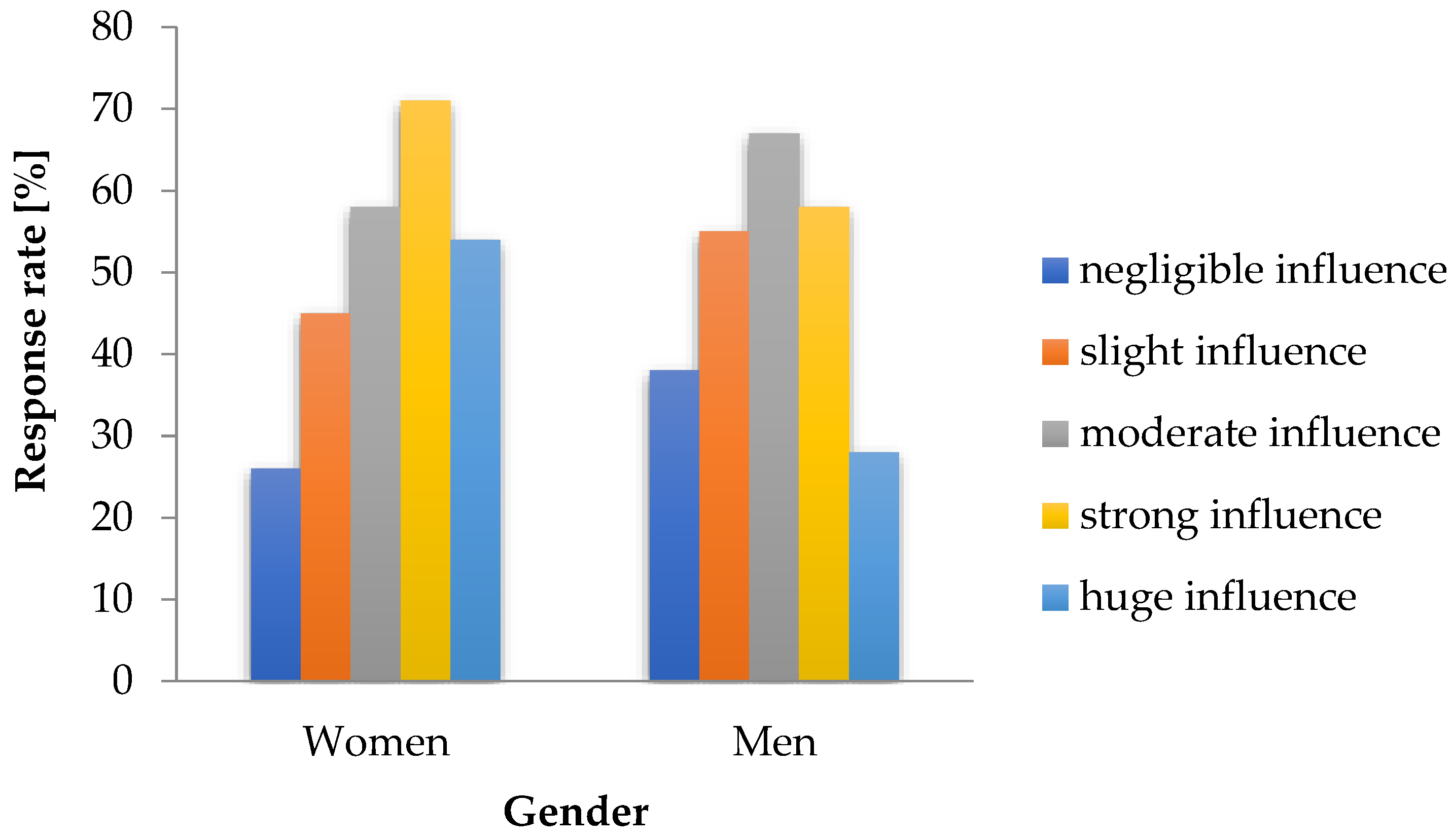
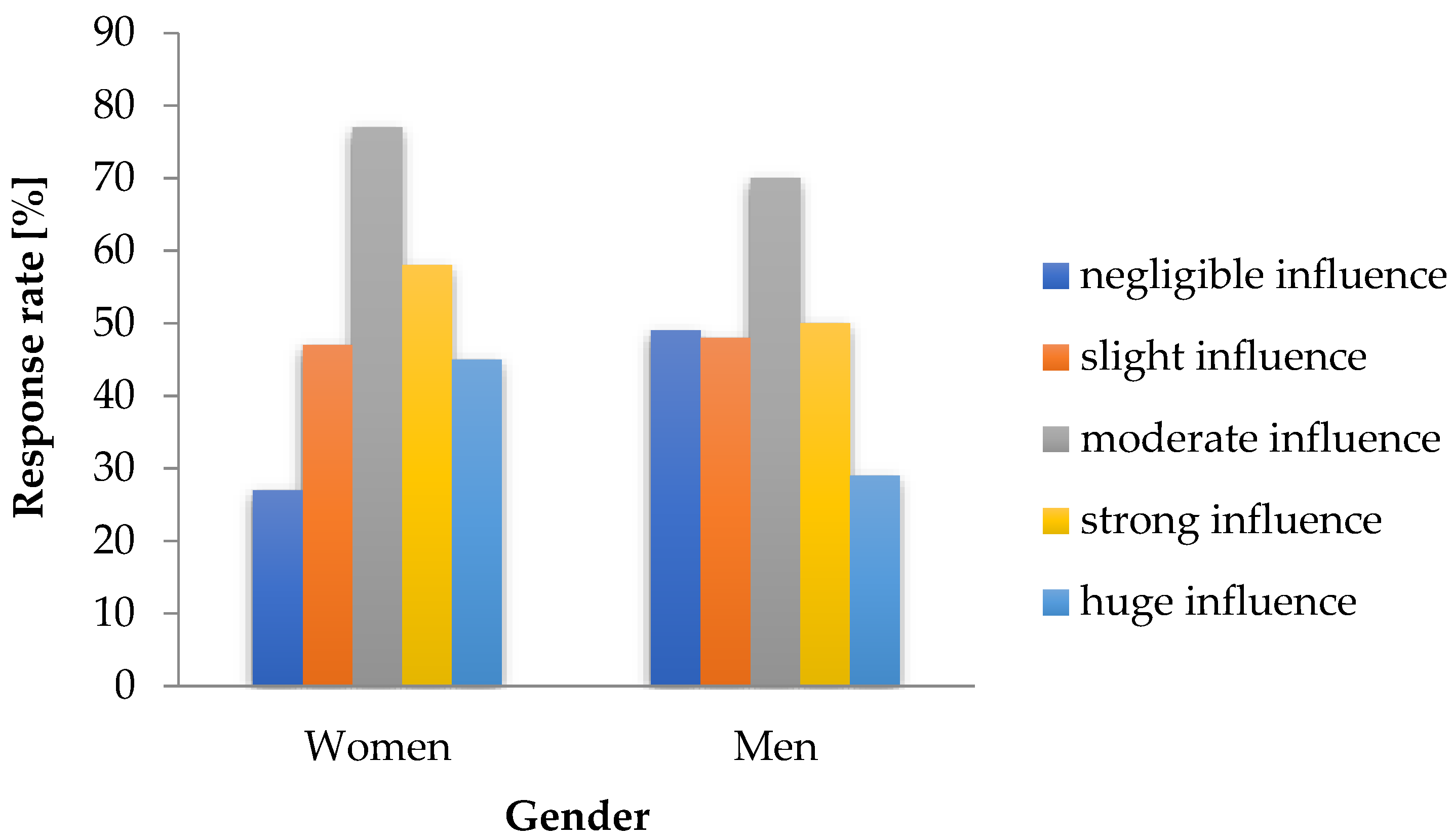
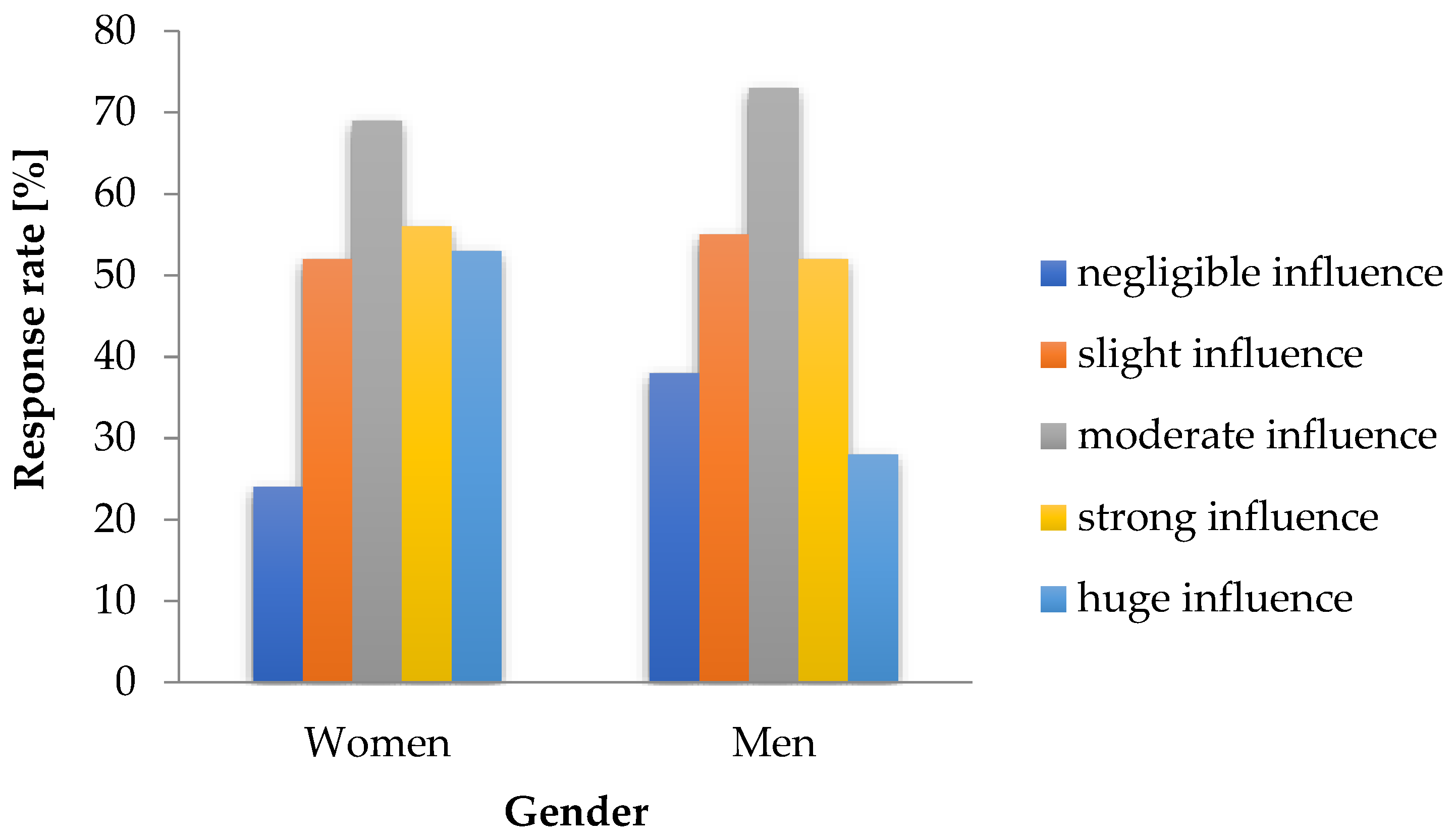
| Total | Gender | Age | ||||
|---|---|---|---|---|---|---|
| W * | M * | 18–35 * | 36–55 * | 56–80 * | ||
| n | 500 | 254 | 246 | 286 | 146 | 68 |
| % | 100 | 50.80 | 49.20 | 57.20 | 29.20 | 13.60 |
| Statement Number | 1 | 2 | 3 | 4 | 5 | 6 | 7 | 8 | 9 | 10 |
|---|---|---|---|---|---|---|---|---|---|---|
| Gender χ2crit. = 9.49 | χ2calc. | |||||||||
| 2.89 | 16.00 * | 6.22 | 3.26 | 13.35 * | 13.33 * | 10.64 * | 11.10 * | 9.42 | 7.31 | |
| Age χ2crit. = 15.51 | 9.97 | 6.42 | 3.37 | 12.55 | 14.61 | 3.90 | 3.97 | 4.79 | 8.12 | 8.67 |
| The Issue Considered in the Statement: Innovative Technical Solutions for the Development of the “Sponge City” Concept Affect … | Value of the Feature-Statement Significance Index (FSI) | |||||
|---|---|---|---|---|---|---|
| Total | Gender | Age | ||||
| W * | M * | 18–35 * | 36–55 * | 56–80 * | ||
| Improvement in the efficiency of water retention in the ground | 1.06 | 1.15 | 0.95 | 1.04 | 1.02 | 1.24 |
| Sustainable functioning of cities in terms of the natural water cycle | 0.95 | 1.27 | 0.72 | 1.02 | 0.95 | 0.71 |
| Improvement in the sustainability of freshwater collection | 1.28 | 1.65 | 1.00 | 1.35 | 1.26 | 1.09 |
| Reduction in sewage volume and in sewage treatment system loading | 1.18 | 1.32 | 1.06 | 1.22 | 1.04 | 1.35 |
| Mitigation of the adverse effects of heavy rainfall | 1.12 | 1.11 | 1.12 | 1.14 | 0.94 | 1.43 |
| Improvement in the conditions for the functioning of urban ecosystems and green areas | 1.29 | 1.76 | 0.92 | 1.31 | 1.11 | 1.67 |
| An increase in the awareness of city residents about the importance of small water retention | 1.06 | 1.39 | 0.81 | 1.21 | 0.87 | 1.39 |
| An increase in the investment in research on innovative technical solutions | 1.12 | 1.43 | 0.86 | 1.12 | 1.08 | 1.28 |
| An increase in competition among companies dealing with innovative technical solutions | 0.93 | 1.23 | 0.70 | 1.11 | 0.75 | 0.70 |
| A decrease in the price of these solutions | 0.88 | 0.98 | 0.80 | 0.92 | 0.88 | 0.73 |
Disclaimer/Publisher’s Note: The statements, opinions and data contained in all publications are solely those of the individual author(s) and contributor(s) and not of MDPI and/or the editor(s). MDPI and/or the editor(s) disclaim responsibility for any injury to people or property resulting from any ideas, methods, instructions or products referred to in the content. |
© 2025 by the authors. Licensee MDPI, Basel, Switzerland. This article is an open access article distributed under the terms and conditions of the Creative Commons Attribution (CC BY) license (https://creativecommons.org/licenses/by/4.0/).
Share and Cite
Kłopotek, K.; Ocieczek, A. Public Perception of Innovative Technical Solutions for the Development of the ‘Sponge City’ Concept in Poland: A Case Study of the Tri-City Area. Sustainability 2025, 17, 2380. https://doi.org/10.3390/su17062380
Kłopotek K, Ocieczek A. Public Perception of Innovative Technical Solutions for the Development of the ‘Sponge City’ Concept in Poland: A Case Study of the Tri-City Area. Sustainability. 2025; 17(6):2380. https://doi.org/10.3390/su17062380
Chicago/Turabian StyleKłopotek, Katarzyna, and Aneta Ocieczek. 2025. "Public Perception of Innovative Technical Solutions for the Development of the ‘Sponge City’ Concept in Poland: A Case Study of the Tri-City Area" Sustainability 17, no. 6: 2380. https://doi.org/10.3390/su17062380
APA StyleKłopotek, K., & Ocieczek, A. (2025). Public Perception of Innovative Technical Solutions for the Development of the ‘Sponge City’ Concept in Poland: A Case Study of the Tri-City Area. Sustainability, 17(6), 2380. https://doi.org/10.3390/su17062380






